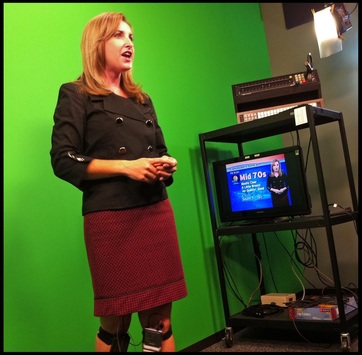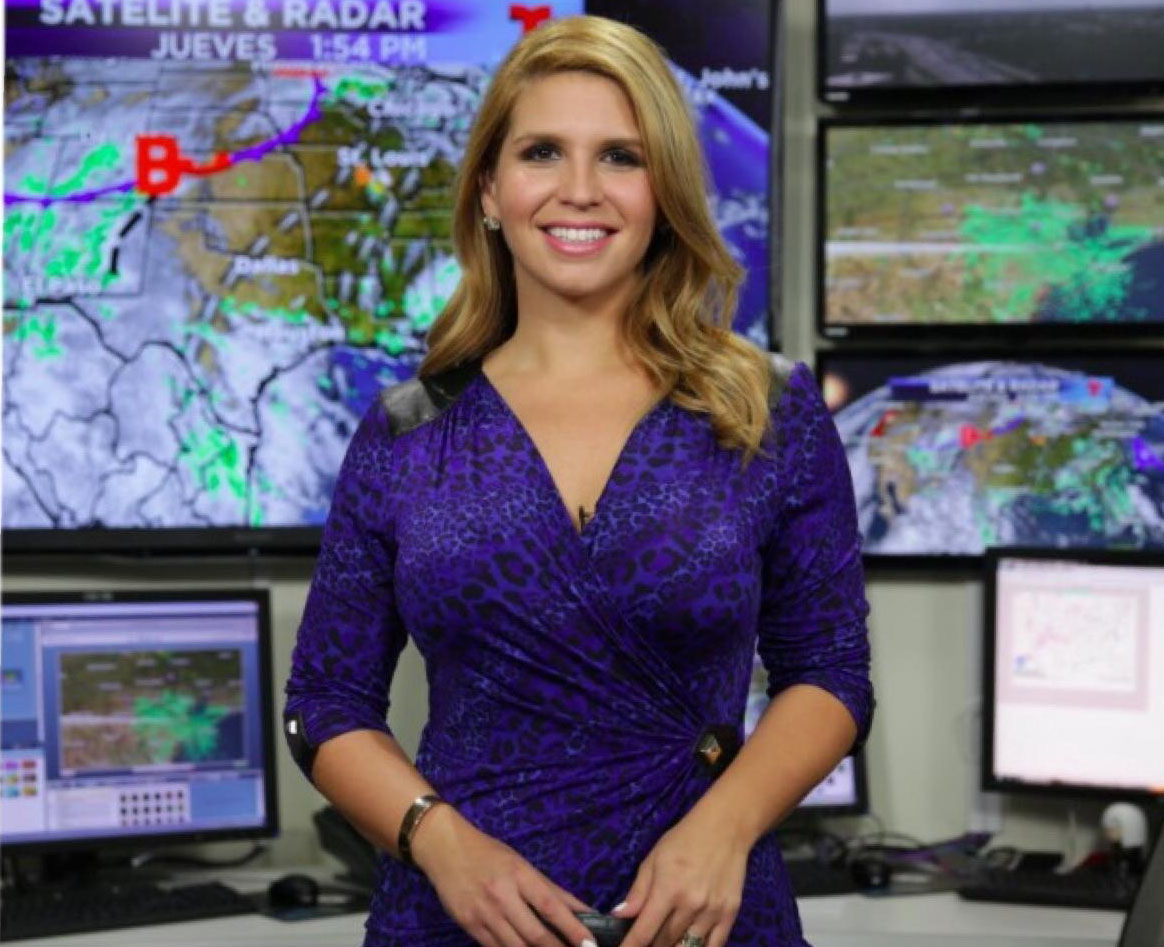A respected credential
-
Respect of your peers
AMS certification holders are highly respected among their peers. Professional meteorologists have confidence that weather presentations made by CBMs will be technically sound and responsibly delivered.
-
Professional recognition
The CBM designation is granted to broadcast meteorologists who meet established criteria for scientific competence and effective communication skills in their weather presentations.
-
Confidence of the general public
The general public has confidence in the quality and reliability of weather presentations made by broadcast meteorologists who have been certified by the AMS.
Resources and information
-
Science news to educate your audience
Broadcast meteorologists are often the only people in television newsrooms who have a background in science. That makes you qualified not just to deliver the weather, but also to provide more science news to your viewing audience. The AMS Station Scientist initiative helps you quickly respond to breaking news involving natural disasters, hazmat situations, and other events where a scientist can add important perspective and information to coverage of the event. Links to instant information about these and other important subjects are readily available on the Station Scientist site.
-
Monthly newsletters
Certification holders receive monthly ‘AMS Items of Interest’ e-newsletters filled with useful information such as professional development and networking opportunities, community involvement resources , free weather tools and graphics, and other helpful materials.
-
Social media
AMS certification holders can discuss topics of interest and ask and give advice to each other through the AMS Certification Programs Facebook page, available only to active CBMs and Sealholders. The CBM logo may only be displayed by individuals who have earned the designation. This mark of distinction displayed on your social media sites and during your weather broadcasts sets you apart as an expert in communicating complex weather information.
Career opportunities
-
Professional Development
A 28 point professional development requirement every 5 years helps keep you abreast of new scientific research and tools. Attending conferences, serving as a lead forecaster on special events, mentoring a high school student, participating in a NWS workshop or a vendor sponsored training activity are just a few of the many ways to stay current in the field.
-
Networking opportunities
Join hundreds of other broadcast meteorologist at the annual AMS Conference on Broadcast Meteorology and hear the latest research in your field. Make a presentation yourself and share your scientific knowledge and experience as a broadcast meteorologist with other attendees. Enroll in a short course in conjunction with the meeting and sharpen your skills by learning more about climate change, GOES-R and other interesting topics. Better yet, join the Board of Broadcast Meteorology, made up of other CBMs, and become an instrumental part in planning future conferences and events.
-
Career Advancement
AMS certifications have been nationally recognized as the standard in meteorological certification since 1957 and news directors and station manager understand the high level of expertise that comes with receiving the Certified Broadcast Meteorologist (CBM) designation. Earning a CBM will set you apart from other candidates and provide you with a competitive edge.
Eligibility requirements revised as of February 2020.
On 7 February 2020, the AMS Council upon recommendation of the Board of Broadcast Meteorology approved a change to the CBM application requirements. As of March 15th, in order to be eligible to apply for the CBM, an individual must hold a degree in meteorology (or equivalent) from an accredited college/university* and have at least two years full time or three years part time experience as an on-air broadcast meteorologist at a local television station and/or national network. College experience at a student-run station does not qualify for this work requirement. Candidates who have already submitted an application, or who submit an application prior to the March 15th deadline, will be reviewed under the former requirement.
*Some degrees in meteorology may not meet eligibility requirements. Please reference the below list of required coursework to see if your degree program meets the CBM course requirements. Individuals who do not have an equivalent degree in atmospheric science or meteorology must have completed the following degree equivalent coursework:
- Atmospheric Dynamics (at least 3 semester hours)
- Atmospheric Thermodynamics (at least 3 semester hours)
- Atmospheric Physics or Physical Meteorology (at least 3 semester hours)
- Synoptic Meteorology (at least 3 semester hours)
- Mesoscale Meteorology (at least 3 semester hours)
- Atmos. Meas. & Instrumentation or Remote Sensing (i.e. Satellite/Radar Meteorology) (at least 3 semester hours)
- At least 3 semester hours in Applied/Specialty Meteorology such as: advanced dynamics, agricultural meteorology, air pollution meteorology, applied climatology, aviation meteorology, broadcast meteorology, hydrology or hydrometeorology, physical oceanography, tropical meteorology, and weather forecasting
- Up to 3 semester hours of a synthesizing experience such as work experience, internship, capstone course or research project
- A sequence of calculus (typically 3 courses) that includes:
- Differential and integral calculus
- Vector and multivariable calculus
- Probability and Applied Statistics
- Physics (a calculus based course with a lab covering fundamentals of mechanics and thermodynamics)
- An appropriate level of coursework or demonstrated competency in Computer Science in data analysis, modeling, and visualization to allow inferences about the atmosphere; software development; and application of numerical and statistical methods to atmospheric science problems.
- An appropriate level of coursework or demonstrated competency in Communication to effectively communicate and interact with scientific, technical, and lay audiences using scientific evidence; discuss and interpret current weather and climate events and forecasts through multiple modalities, including social media; and craft a scientific presentation and write a scientific report.
- A course covering Earth’s climate system (such as a course on climate change or Earth system science)
Whenever possible and where appropriate, course requirements should include components that utilize modern computer and instrumentation labs and facilities. Please keep in mind that some schools may require pre-requisite courses prior to enrolling in the above coursework.
 Applicants must pass a “closed book”, qualifying examination to demonstrate knowledge of general meteorology. A test of 100 multiple choice and true/false questions will be administered at a test center or remotely by SMT/Promteric through an online proctored environment. Applicants must have a grade of 75 or higher in order to pass the written exam. You will receive information on how to register for the exam once you apply. Please note that you will be unable to register for the exam through SMT/Prometric until you submit a CBM application and receive an acknowledgment letter from AMS. If you would like to retake the test, please contact AMS Headquarters before you re-register at Prometric.
Applicants must pass a “closed book”, qualifying examination to demonstrate knowledge of general meteorology. A test of 100 multiple choice and true/false questions will be administered at a test center or remotely by SMT/Promteric through an online proctored environment. Applicants must have a grade of 75 or higher in order to pass the written exam. You will receive information on how to register for the exam once you apply. Please note that you will be unable to register for the exam through SMT/Prometric until you submit a CBM application and receive an acknowledgment letter from AMS. If you would like to retake the test, please contact AMS Headquarters before you re-register at Prometric.
After successfully passing the multiple choice exam, applicants will receive instructions on submitting two working weathercasts for review by the AMS Board of Broadcast Meteorology with one of the submissions coming from a day on which the weather would be considered “active”; the other from a day on which the weather would be considered “routine” for the broadcast market.
No minimum time of each segment is required. However, there is a maximum time limit of 5 minutes per segment. Submitted segments must be complete, as broadcast, in their entirety. For example, submitting the first half of a 5pm show and ending with part of a 10pm show, for one of the two (2) days is not permitted. Those whose weathercasts are short in time, but frequent in number (morning shows, cable news, etc.), may wish to include several consecutive segments, that approximate a single "full weathercast" when combined, for each day. Anyone exercising this option must clearly state such.
Weathercasts may be submitted in Spanish and will be evaluated by the AMS standing Board of Spanish-language evaluators. An English-language transcript of the broadcasts is required, but closed captioning is not. Please indicate on your application if you would like to submit Spanish-language weathercasts.
Off-air weathercasts will not be accepted, with the exception of those from applicants not currently employed or not employed as an on-air meteorologist at a local television station. In this case, to better simulate the “on-air experience,” a single take with no post-production is required, and it must be recorded with current rather than archived data. The forecast and required climatology sheet should focus on one specific location.
Past AMS Broadcast Board Chairs Carrie Rose and Rob Eicher offer tips and advice on the CBM weathercast evaluation.
Active Day
The definition of "active" may vary from one market to another; for instance, an "active" day in the central United States could mean thunderstorms, while an "active" day on the Pacific coast could be rain and fog, and an "active" day in the Great Lakes could mean lake effect snow. Some other examples of an active day could be involving tropical weather, a commute impacted by snow/ice, wildfire coverage, high winds, heavy rain and flash flooding, dense fog, or poor air quality. Your active day should showcase your best work on a day when a weather event will impact your viewers and may have the potential to be a threat to life and property. An active day may also be when weather is the top story in the newscast.
Routine Day
A “routine” day should showcase your best work on a quiet, typical weather day. The submissions do not need to be from consecutive days; however, they must be from the time period of two months prior to the request to submit air checks, to two months after the notice.
Submitted weathercasts should be of your best work and should follow the guidelines outlined above. If submissions do not meet these guidelines, your grade will reflect any deficiencies.
Examples of a Weathercast Submissions Graded Favorably
The below links are examples of weathercast submissions that have met the requirements and were graded favorably by the Board of Broadcast Meteorologists. Also included are comments from the reviewers. These have been provided so that you will have a better idea of what to include in your submissions.
Active weathercast example Routine weathercast example Reviewer comments
Active weathercast example Routine weathercast example Reviewer comments

Review Criteria
The Board will review the submissions based on three criteria:
a) Graphical Content - This category will be used to evaluate the visual presentation and clarity in creating the proper storyline to the local weather.
b) Explanation - Reviewers are asked to determine whether or not the candidate has given scientifically valid explanation of the processes that produce the recent, current, and anticipated weather conditions
c) Presentation - This criterion is intended to measure the candidate’s ability to communicate the weather story to their audience.
A candidate must score above a 3.0 average in each category in order to succeed on the evaluation.
Supporting Documents
Board Statement on Weathercast Submission Requirements
Tips from the Board of Broadcast Meteorology for Earning a CBM
Required Application Materials
- CBM application
- College/university transcript(s)
Application Fees
- Application Fee: $330 for AMS Members / $660 for Non-members* †
- Reapplication Fee: $100 for AMS Members / $200 for Non-members
- CBM Examination Fee: $60 for remote proctoring exam / $75 for exam administered at United States testing facility / $85 for exam administered at international testing facility
- Annual CBM & TV/Radio Seal Renewal Fee: $200 for AMS Members / $500 for Non-members
*Non-members may apply for AMS membership and pay the member rate; application fee does not include CBM Examination Fee paid directly to the Prometric SMT testing center each time the CBM exam is scheduled.
† Many television stations will cover the application and/or renewal cost of the CBM for their meteorologists. The Board of Broadcast Meteorologists has created talking points to help facilitate a discussion with a news director on the investment value of the CBM:
- Brings more credibility to the station since viewers are assured there is a Certified Broadcast Meteorologist on staff who has science knowledge of weather and how it works, and is able to communicate that in an understandable, tangible way.
- Recognizes meteorologists for the dedication they put into forecasting and delivering/presenting the most accurate forecast possible to their viewers.
- A CBM will allow the meteorologist an avenue for growth through continuing education from AMS conferences, programs, and webinars
- Public station events such as weather or science-related school visits or weather radio programming events can be counted towards recertification points to help motivate a CBM, retaining their certification status.
- It is the highest seal a meteorologist can have, that can only be earned by holding an accredited meteorology degree
- Once a meteorologist holds a CBM seal, it will differentiate them from other forecasters in the market
This study guide provides test topics and references to assist you in preparing for the AMS Certified Broadcast Meteorologist (CBM) Program written test. Applicants must pass the written exam with a score of 75% or higher. Please review the AMS Disclaimer before visiting the any of the linked sites in this study guide.
COMET Modules/VISIT Training Sessions
The completion of the following COMET modules and VISIT training sessions are recommended as part of the CBM exam study process.
Topic References
The test will consist of 100 multiple choice and true/false questions covering the topics listed on the page linked below. Links to online instruction are provided for each topic.
The Certified Broadcast Meteorologist (CBM) Program was inaugurated on 1 January 2005. The goal of the program is to certify that the holder meets specific educational and experience criteria and has passed rigorous testing in their knowledge and communication of meteorology and related sciences needed to be an effective broadcast meteorologist. Since the broadcast meteorologist is the primary representative of the meteorological profession to the public, we, as meteorologists, have a responsibility to help recognize those who are competent.
 The Certified Broadcast Meteorologist (CBM) program was established to raise the professional standard in broadcast meteorology and encourage a broader range of scientific understanding, especially with respect to environmental issues. Among radio and television meteorologists, the CBM designation is sought as a mark of professional distinction and recognition.
The Certified Broadcast Meteorologist (CBM) program was established to raise the professional standard in broadcast meteorology and encourage a broader range of scientific understanding, especially with respect to environmental issues. Among radio and television meteorologists, the CBM designation is sought as a mark of professional distinction and recognition.